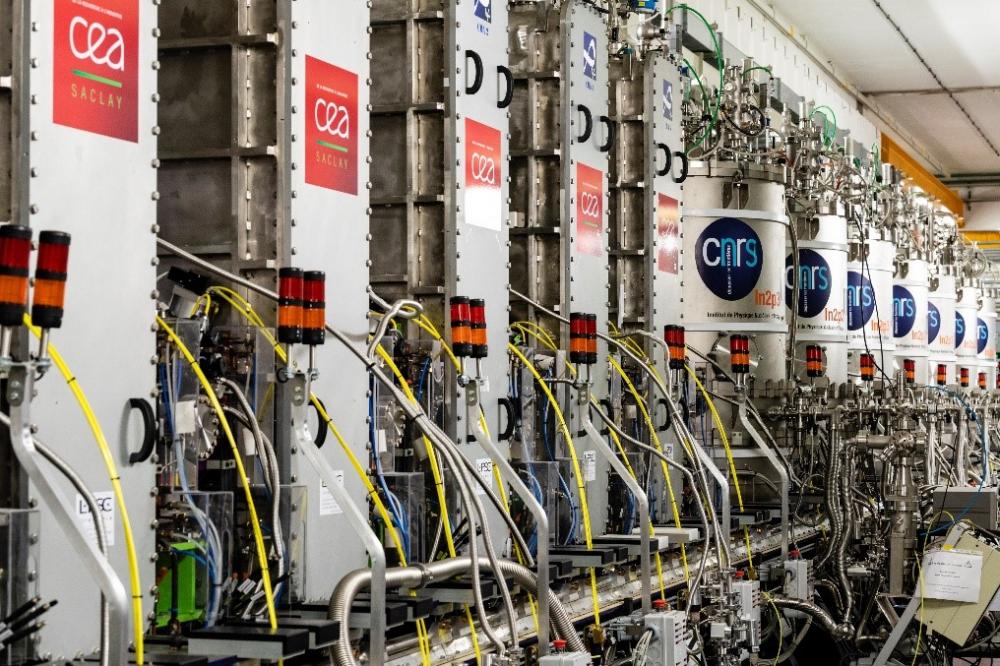Following SPIRAL2's commissioning authorization issued by the French Nuclear Safety Authority (ASN) on July 8, 2019, many crucial steps were successfully completed by the end of 2019. A first proton beam was accelerated to 33 MeV, the nominal energy by the SPIRAL2 linear accelerator (LINAC) and a first test experiment was achieved the Neutron For Science (NFS) experimental room.
These first results in 2019 are very promising. They will continue in 2020 with the increase in beam power up to 10% of the maximum design power. In parallel test experiments in NFS will be carried out.
Thanks to the unfailing commitment of the GANIL teams and partner laboratories from the CEA, CNRS and foreign laboratories, the schedule envisaged at the beginning of 2019 was completed a few weeks ahead of schedule.
The main steps are summarized below:
- 8 July 2019: GANIL received notification of ASN's decision authorizing the commissioning of phase 1 of GANIL's SPIRAL2 extension.
- 26 July 2019: a first radio frequency (RF) injection was carried out in a cold cavity (at 4 degrees Kelvin). This first raising in field of this superconducting cavity on the GANIL site validate the installation procedures, the absence of internal pollution and the performance of the cryomodule on site.
- September 24, 2019: the qualification of all the 26 LINAC accelerating cavities is finalized. The measurements obtained are well in line with those expected. This stage also made it possible to validate the cryogenic performance of the entire accelerator.
- October 28, 2019: all the elements required for beam injection into LINAC are validated. Indeed, in parallel with the technical tests, the 130 safety prerequisites for beam into LINAC have been validated since July 2019.
Thus, safety prerequisites and technical systems were in place on October 28th, for the first injection of a proton beam into LINAC's cryomodules.
- 28 October 2019 at 12h53 minutes: a historic moment, the last Faraday cup before the LINAC was lifted, allowing for the first time a proton beam to travel through SPIRAL2's accelerator. The pre-accelerated proton beam start to be tuned at the RFQ energy.
- November 26, 2019: LINAC cavities reached their nominal field and accelerated a proton beam to its nominal energy value of 33 MeV.
- 11 December 2019: the significant involvement of teams from the Nuclear Physics Institute of the Czech Republic (NPI) and GANIL made it possible to carry out a first test experiment with the irradiation station and the fast pneumatic sample transfer system. A first disintegration spectrum was obtained during the irradiation test of a 33 MeV proton beam on a copper target in the NFS experimental hall.
Objective of 10% beam power by 2020
It was the end for 2019. Since December 13, the facility was shut down for its annual maintenance period. The cavities are warmed up to room temperature, and put to rest for the winter break. A truce that will not be too much to learn from these first months of commissioning and to solve the problems detected. LINAC will then resume service in April and take advantage of the spring to gradually ramp up.
"The current beam is only a few watts, it will have to reach 200 kW in the long term," explains Patrick Dolegieviez, SPIRAL2 accelerator project manager. "This power will only be reached if we fine-tune the machine and keep the losses below a maximum of 1 watt per meter. This is a challenging control of the beam (very small value compared to a 200kW power beam)".
If all goes well, the NFS teams will finally take action, with a schedule split between the machine's ramp-up (target of 10% of the maximum power expected in 2020) and test experiments for physics.
Contacts Ganil: Patrick Dolegieviez (Project manager SPIRAL2 accelerator)
• Accelerators, Cryogenics and Magnetism Division (DACM) • The Electronics, Detectors and Computing Division • The Systems Engineering Division





